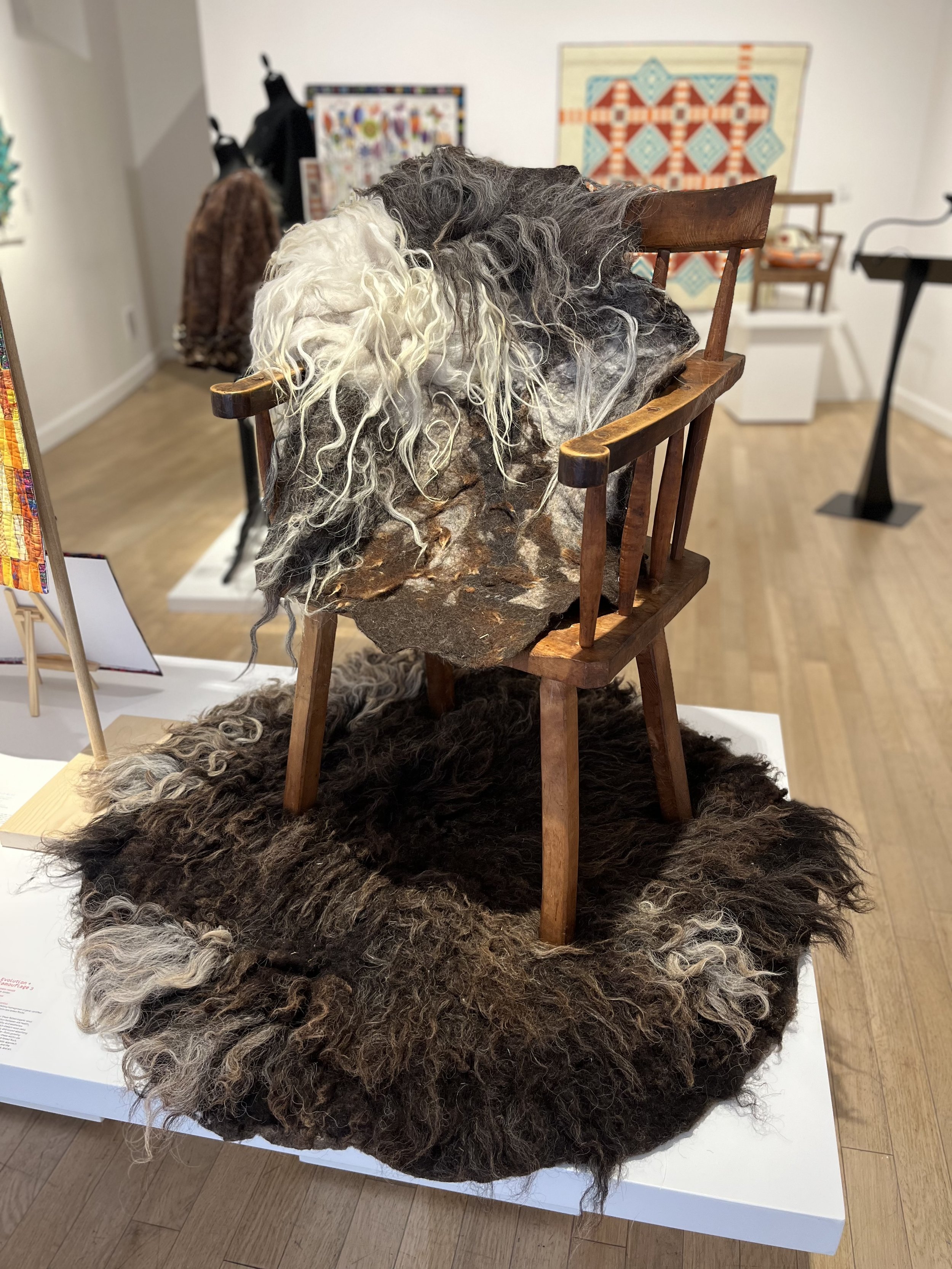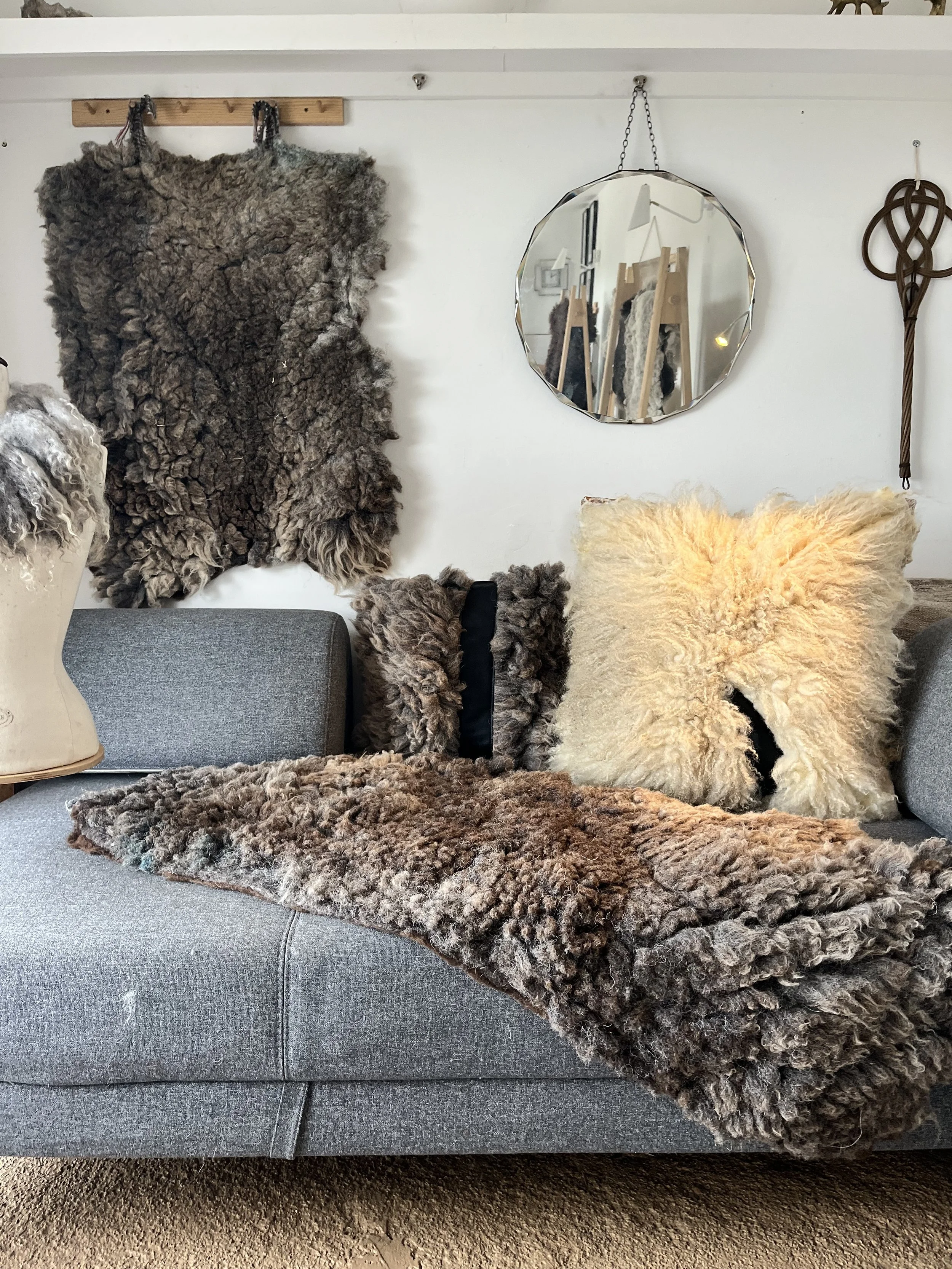13. Designing Wool Products
While designing and developing wool products my process has been very different from projects I have worked on in the past. Typically at the beginning of a design project, a brief is devised where details such as the scope of the work required, budgets, materials, etc are all teased out between client and designer. The concept generation phase commences with many being discarded, some being developed further, and out of that process a clear direction emerges.
With the wool from my sheep, it all starts with the wool, not a brief. Each time I take a fleece out of it’s storage bag, I have no clear direction at first as to what I am going to make with it. Some fleeces are excellent with a defined structure and they hold together beautifully. These will automatically be made into rugs. Others are more bitty, or are very soft in the case of shearlling fleece which is the first shearing from a lamb. These are really special because they have the little curly lamb tips - the little locks that the lamb was born with.
Some fleeces are full of vegetable matter such as straw or hay. Before the shearer arrives I need to bring the sheep in from the fields and separate them into groups according to colour to make the wool sorting easier after they are shorn. Occasionally the sheep can escape into a shed where there is straw on the ground and hay bales piled up. They have a field day and often don’t get discovered for a few hours, and I find them cosy, bellies full, mischievously but innocently looking at me when I see their wool, which to my dismay is now full of straw and hay.
If this is the case there is no way I can removed every single bit of matter or grass seed, and I just accept that. When making a rug for an art piece, it’s ok for some vegetable matter to be in the wool as it is part of the story. However if I am making a rug or a smaller piece that will become a cushion then that’s not ok and clients would not be happy having that in their house. It’s the same for the lanolin and the subject of washing (scouring) the wool. If a tuffet is being made for someone to use in their tractor - vintage tractors especially are bone shakers and you can feel like your body has been through a washing machine after a few hours. In this instance I would not wash all the natural oils from the wool because there is a water resistance there which will preserve the tuffet for a longer time. Contrarily if the tuffets are for a home, then they would be fully scoured so that there is no residual sheepy smell coming from the product.
I love that the material decides it’s own outcome. Wool is such a beautiful fibre, full or colour, texture, shade, light, coarse hairs sitting alongside fluffy soft locks and curls. I love the feel of it and am fascinated by fleece in it’s raw form way before it gets washed, combed, carded, and spun into yarn. In fact yarn doesn’t pique my interest - it is far from the sheep and I love working with the fleece in a way that it looks as close as possibly to how it looked on the sheep the day before or the month before. Three pieces that were chosen to be included in a beautiful exhibition at the National Design & Craft Gallery at DCCI in Kilkenny Castle were designed exactly in this way. Each were from individual sheep whose fleeces directed the design.
One sheep who should’ve been jet black when she was born was in fact white. She should have had a black face that gradually changed to white over the space of about six months which is a unique trait of Herdwicks. She was white and her face changed to a spotty black. Either it’s a genetic mutation or a random ram hopped into the field her mother was in - we will never know! The large felted piece I made with her full fleece, was white and I included a black circle feature as a way to reference the anomaly.
A second piece was made from the fleece of the first lamb born on this farm more than 35 years ago, and his fleece is gorgeous every year, with long locks on his back legs. These were highlighted in the design which was crafted into a large circular piece. The final piece was designed to celebrate the variety of wool from my sheep - some tight dark wool combined with long white locks and soft greys in between, it is a very organic piece with a free-flowing form that reflects the natural life they live. The exhibition which ran over three months was a collaborative show between two guilds in Ireland: Feltmakers Ireland and the Quilters Guild of Ireland. Championing contemporary and traditional techniques and styles, as it draws to a close, Brian Byrne Gallery Co-ordinator says that 15,000+ visitors have viewed the exhibition making it one of the most successful that they have ever run with 45 different textile workers and artists showcased. Running from August 7th 2025 to November 1st 2025 it has been incredible to to part of it, showing how materials can direct design concepts when their natural characteristics are featured and worked with, not against.












